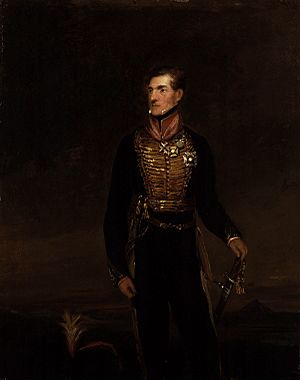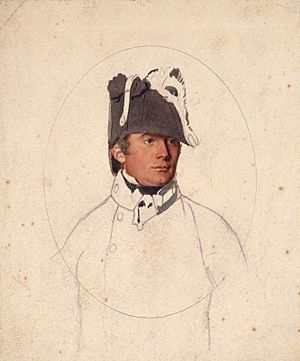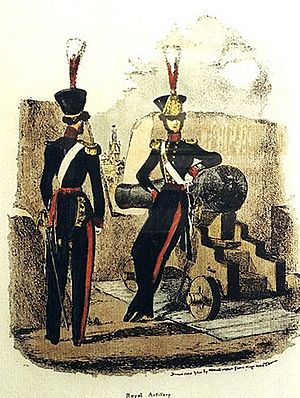Hew Dalrymple Ross facts for kids
Quick facts for kids
Sir Hew Dalrymple Ross
|
|
|---|---|

Portrait by William Salter (oil on canvas, 1834–1840)
|
|
| Born | 5 July 1779 Balkail, Kirkcudbrightshire |
| Died | 10 December 1868 (aged 89) Knightsbridge, London |
| Allegiance | |
| Service/ |
|
| Years of service | 1795–1858 |
| Rank | Field Marshal |
| Commands held | The Chestnut Troop |
| Battles/wars | Irish Rebellion of 1798 Peninsular War Crimean War |
| Awards | Knight Grand Cross of the Order of the Bath |
Sir Hew Dalrymple Ross (born July 5, 1779, died December 10, 1868) was a very important officer in the British Army. He became a Field Marshal, which is the highest rank in the army. He fought in several major wars, including the Irish Rebellion of 1798, the Peninsular War, and the Crimean War. He was known for his leadership in the artillery, which are the big guns used in battles. Later in his career, he held important positions, making sure the British Army's artillery was ready for action.
Contents
Early Life and Military Start
Hew Dalrymple Ross was born on July 5, 1779. His father was Major John Ross. Hew studied at the Royal Military Academy, Woolwich, a famous school for army officers.
He joined the Royal Artillery on March 6, 1795, as a second lieutenant. The Royal Artillery is the part of the army that uses cannons and other big guns. He quickly moved up the ranks. He became a lieutenant in 1796 and a captain lieutenant in 1803.
First Battles and Promotions
Ross saw his first real fighting during the Irish Rebellion of 1798. This was a time of unrest in Ireland. After this, he became an adjutant, helping with the daily running of his unit. By 1806, he was a full captain. He was given command of a special group of horse artillery. This group later became very famous as the Chestnut Troop.
Fighting in the Peninsular War
In 1809, Ross and his Chestnut Troop went to Lisbon in Portugal. They joined Sir Arthur Wellesley's army. This was during the Peninsular War, where Britain fought against France in Spain and Portugal.
Key Battles and Victories
Ross's guns were often with the Light Division, a fast-moving part of the army. He fought in many important battles:
- Battle of the Côa in July 1810
- Battle of Bussaco in September 1810
When the French army started to retreat, Ross's troop chased them. They fought in more battles:
- Battle of Pombal in March 1811
- Battle of Redinha in March 1811
- Battle of Casal Novo in March 1811
- Battle of Sabugal in April 1811
- Battle of Fuentes de Oñoro in May 1811
Because of his bravery and skill, he was promoted to major in December 1811.

More Successes and Higher Ranks
Ross continued to play a key role in the war. He was at the:
- Siege of Ciudad Rodrigo in January 1812
- Siege of Badajoz in April 1812
- Battle of Salamanca in July 1812
After the Battle of Vitoria in June 1813, Ross's guns were always with the most advanced troops. They even captured the last cannon held by the French army. He was promoted to lieutenant colonel in July 1813.
He also fought in the Battle of the Pyrenees in July 1813. Then came battles at Bidassoa in October 1813 and Nivelle in November 1813. During the Battle of the Nive in December 1813, his horse was shot from under him, but he was not hurt. In April 1814, he fought at the Battle of Bayonne.
For his great service, he was made a Knight Commander of the Order of the Bath in January 1815.
Battle of Waterloo
Ross also fought in the famous Battle of Waterloo in June 1815. This was the final defeat of Napoleon Bonaparte. Even though half of his cannons were damaged, the rest helped chase the French army away. He received an award from Russia, the Order of St. Anna, for his actions.
Later Career and Important Roles
After the wars, Ross continued to serve in the army.
In 1825, he became the Artillery Commander for the Northern District of England. This meant he was in charge of all army forces in the four northern counties. He was promoted to colonel in 1830.
Leading the Royal Artillery
He became the Deputy Adjutant-General of the Royal Artillery in 1840. He continued to rise through the ranks, becoming a major-general in 1841 and a lieutenant general in 1851.
In 1854, he took on a very important job: Lieutenant-General of the Ordnance. In this role, he was in charge of all the artillery sent to the Crimean War. He personally made sure that every cannon and artillery unit sent from the United Kingdom was in excellent condition and ready for battle. He also helped start a new testing facility for artillery at Shoeburyness.
He was promoted to full general in November 1854. After some changes in the army, he became the Adjutant-General of the Royal Artillery in 1855. He received an even higher honor, becoming a Knight Grand Cross of the Order of the Bath.
Retirement and Final Years
Ross retired from the army in April 1858. In 1864, he became the Master Gunner, St James's Park. This is a special, honorary position in the Royal Artillery. On January 1, 1868, he was promoted to field marshal, the highest rank possible. A few months later, he became the lieutenant-governor of the Royal Hospital Chelsea, a home for army veterans.
Sir Hew Dalrymple Ross passed away on December 10, 1868, at his home in Knightsbridge, London. He was 89 years old.
Family Life
In 1816, Sir Hew Dalrymple Ross married Elizabeth Graham. They had two sons:
- Major Hew Graham Ross (1817-1848)
- General Sir John Ross, who also became a high-ranking army officer.
Images for kids





